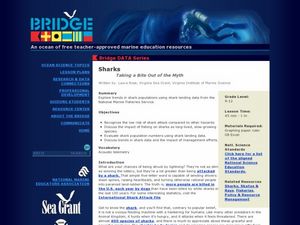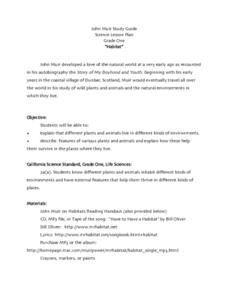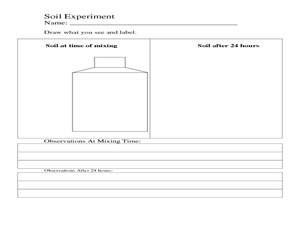Curated OER
Sharks ~ Taking a Bite Out of the Myth
The first thing to know about this lesson plan is that the commercial fisheries data for the activity no longer seems to be available. That being said, there are fascinating links to other websites, some about the comparative odds of...
American Museum of Natural History
Einstein in Time
Einstein sure had an interesting life. Using a remote learning resource, pupils examine a timeline of Einstein's life. They learn about the major scientific discoveries as well as humanitarian and social work. Additionally, they read...
Curated OER
Fire Fighting
Pupils consider the effects of a wildfire on prairie life. They explore the ways that plants regenerate after a fire and create fictional plants that have adapted specifically to the prairie environment. They share models of their plants.
Curated OER
Sheffield Island Adaptation Activity
You don't have to visit The Maritime Aquarium to use this plan, but you would need to find a location where a variety of bird species live, re-write the activity worksheet to incorporate the local species, and purchase field guides for...
Curated OER
A Little Chemistry
The molecular properties of water are the focus of this chemistry-based assignment. Multiple-choice, true-or-false, matching, and fill-in-the-chart style questions query assignees about the forces that hold the water molecule together,...
Curated OER
PLANT LIFE CYCLES
Student learns about the life cycle of plants by watching a time-lapse video. This activity provides students with further evidence that all living things grow and change as they progress through their life cycle.
Curated OER
Water
In this water worksheet, students read an excerpt about the effects of pollution on the life cycle of a lake. Then they describe how lakes are affected by the pollution. Students also define why pollution has become such a problem for...
Curated OER
Birth, Growth, and Development
Students study the growth of humans and animals and their various stages. In this developmental lesson students study the life cycle and what that is in humans.
Curated OER
Something's Fishy
Students study fish habits and traits. In this marine life instructional activity, students complete four learning centers of a fish memory game, a fish habitat study, draw and glue fish craft activity, and a fish read-a-thon. Students...
Curated OER
What's in a Brain?
Bring the brain to life for your students with thought-provoking activities
Curated OER
Science: Life Out of Balance
Students examine the state of the environment by viewing the film, Koyaanisqatsi." The film has no dialogue and presents contrasting images of nature and the modern world. After completing a homework assignment about the film, students...
Curated OER
Monarch Chrysalis
Learners examine the last stage of the monarch butterfly. In this life cycles instructional activity, students read the book The Very Hungry Caterpillar and study photos of the monarch life cycle. Learners illustrate the third stage of...
Curated OER
"Habitat'
First graders explore and explain that different plants and animals live in different kinds of environments. They illustrate various plants and animals and how they survive in the places where they live. A nature journal for enrichment...
Curated OER
Animals and Plants of BC's Rocky Shore
Students fill out a fact sheet and look at diagrams of BC's shore and the animals that live there. In this habitat lesson plan, students discuss the plants and animals and the different zones they live in.
Curated OER
Robotics
Get students thinking about ways to use robots to improve our daily lives with these hands on lesson plans.
Curated OER
Under Our Feet
Students investigate the forest ecosystem to learn of the living and non-living elements of the soil. For this ecosystem lesson, students examine soil for twigs, moss, fungi, leaves, roots and other matter. Students...
Curated OER
Soil Composition
Young scholars examine soil. In this soil composition lesson students participate in soil sedimentation and filtration activities. The young scholars discuss what non-living and living things are in soil and why it is so important.
Curated OER
What is Soil?
Young scholars examine soil. For this earth science lesson, students define and describe weathering and erosion as it relates to soil. Young scholars compare and contrast potting soil with forest soil and complete a science observation...
Curated OER
Middle and Recent Earth History
In this middle and recent Earth history worksheet, learners are given 20 statements about the changes in the Earth and life on Earth and they determine if they are true or false. If the statements are false, students change the...
Curated OER
Early Earth History
In this earth history worksheet, learners answer 12 questions about geological time, the eras of Earth, the changes taking place in early Earth and the life present during the eras. They also answer 2 questions about the Paleozoic Era.
Curated OER
Tree Birthdays
Students investigate the growth of trees. In this tree growth lesson plan, students discover that trees make a ring each year they live. Students use new voabulary such as bark, phloem, and cambuim to talk about tree parts. Students...
Curated OER
Deep Time
Young scholars compare geologic time periods to the calendar year. They set up a live-action student timeline in the classroom.
Michigan Sea Grant
Fish Identification
Using a dichotomous key, pupils identify characteristics of fish who live in the Great Lakes and explain how these features help them survive. In small groups, class members discover what features scientists consider important and...
Curated OER
Using Abiotic and Biotic Parameters to Monitor Air Quality
Students identify the abiotic factors that influence a river or stream and the organisms that live in it. They measure several abiotic and biotic parameters to gauge water quality. Students examine the biotic environment by identifying...






















